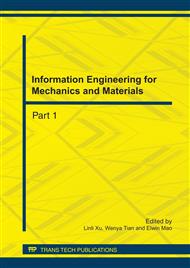[1]
Y. Yamamoto and X. Yun, Coordinating locomotion and manipulation of a mobile manipulator, IEEE Trans. on Automatic Control, Vol 39, No. 6, pp.1326-1332, (1994).
DOI: 10.1109/9.293207
Google Scholar
[2]
Saha K. S. and Angeles J. Dynamics of Nonholonomic Mechanical Systems using a Natural Orthogonal Complement, ASME J. of Applied Mechanics, March 1991, Vol. 58, pp.238-243.
DOI: 10.1115/1.2897157
Google Scholar
[3]
Nevile Hogan. Impedance control an approach to manipulation[J] . ASME. J . DSMC. 1985 , 107 , 1-24.
Google Scholar
[6]
R. Anderson and M. W. Spong, Hybrid impedance control of robotic manipulators, Proc. of the 1987 IEEE Conf. on Robotics and Auto., pp.1073-1080.
DOI: 10.1109/robot.1987.1087919
Google Scholar
[4]
R. Anderson and M. W. Spong, Hybrid impedance control of robotic manipulators, Proc. of the1987 IEEE Conf. on Robotics and Auto., pp.1073-1080.
Google Scholar
[5]
Z. Wang, C. Su, and S. S. Ge, Adaptive control of mobile robots including actuator dynamics, in Autonomous Mobile Robots: Sensing, Control, Decision Making and Application, S. S. Ge and F. L. Lewis, Eds. London, U.K.: Taylor & Francis, 2006, pp.267-293.
DOI: 10.1201/9781420019445.ch7
Google Scholar
[6]
D. Xu, D. B. Zhao, J. Q. Yi, X. M. Tan, Robust adaptive control for omnidirectional mobile manipulator, Proc of the 2007 IEEE International Conference on Intelligent Robots and Systems, pp.3598-3603, (2007).
DOI: 10.1109/iros.2007.4399027
Google Scholar
[7]
Mohamed Boukattaya, Tarak Damak, Mohamed Jallouli. Robust Adaptive Control for Mobile Manipulators. International Journal of Automation and Computing, PP. 8-13, (2011).
DOI: 10.1007/s11633-010-0548-y
Google Scholar
[8]
M. P. Cheng and C. C. Tsai, Dynamic modeling and tracking control of a nonholonomic wheeled mobile manipulator with two robotic arms, in Proc. 42nd IEEE Conference on Decision and Control, Vol. 3, 2003, pp.2932-2937.
DOI: 10.1109/cdc.2003.1273071
Google Scholar
[9]
SHIH-TIN LIN and JIEN-SHUIN LEE, Impedance Control with On-Line Neural-Network Compensator for Robot Contact Tasks, Journal of lntelligent and Robotic Systems 1996(15): 389-399.
DOI: 10.1007/bf00437603
Google Scholar
[10]
L. Huang, S. S. Ge, T. H. Lee, AN ADAPTIVE IMPEDANCE CONTROL SCHEME FOR CONSTRAINED ROBOTS, International Journal of Computers, Systems and Signals, Vol. 5, No. 2, 2004, pp: 17-26.
Google Scholar


